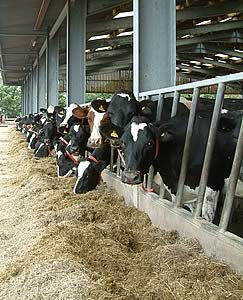| 09/11/07
Increasing standard mineral premix supplementation levels
to overcome dietary shortfalls in minerals may not be economic
and may even supply excess levels of trace elements, warns
Trouw Nutrition.
Low forage mineral levels and changes to
ration ingredients are creating mineral
supplementation issues on many dairy units.
|
The company says that its Minlink mineral optimisation
program is calling for extra calcium and phosphorus on
many dairy units. This is partly because this season’s
forage levels are low, but also because of the change in
ration ingredient inclusion.
“Cereals – traditionally a good source of phosphorus – are
being included at lower levels in diets because of their premium pricing. But
simply increasing the feeding rate of your standard mineral to compensate is
not the answer,” points out Trouw Nutrition technical manager John Twigge.
“In these situations, it is likely to be more beneficial to keep the mineral
feeding rate at the recommended level and then add additional salt, phosphorus
and limestone to the ration – it is far more cost-effective and you will
not end up oversupplying vitamins and trace elements, which is wasteful and potentially
harmful in some circumstances.
“The need for additional inputs of these key major minerals is so widespread
that we are introducing a special macro-mineral package, Eco TMR Balancer, to
our range this winter. This allows the macro-mineral deficit to be plugged by
a single product rather than four separate additions of mineral, limestone, phosphorus
and salt,” Mr Twigge points out.
John Twigge says that Minlink is also showing that some rations are already very
high in iron and this has the potential to generate a number of additional problems.
“The wet harvesting conditions this year led to a lot of silages being
contaminated with soil and this has pushed up ration iron levels. Iron is a very
powerful oxidant and if levels are too high, silent heats, uterine infections,
foot soreness and rough coats can be the potential consequences.”
Mr Twigge says that simply lowering iron levels by not adding any supplementary
levels of the trace element will not necessarily solve the problem. “Sometimes
you will even need a special mineral formulated from raw materials with exceptionally
low background iron levels. It’s also worth making sure this special mineral
is fortified with high levels of anti-oxidants, such as vitamin E, copper or
selenium sources to offset the impact of any excessive iron from the diet or
water supply.”
Producers concerned about mineral supply issues this winter can ask for a free
Minlink assessment by calling Trouw Nutrition customer services on 0845 300 5858.
 Free Cattle Rationing Advice for Suckler Herds at Beef BRP Workshop Free Cattle Rationing Advice for Suckler Herds at Beef BRP Workshop
 Amino Gold Lifts Milk Yields Amino Gold Lifts Milk Yields
 Cull Barren Cows Early to Cut Winter Feed Costs Cull Barren Cows Early to Cut Winter Feed Costs |


